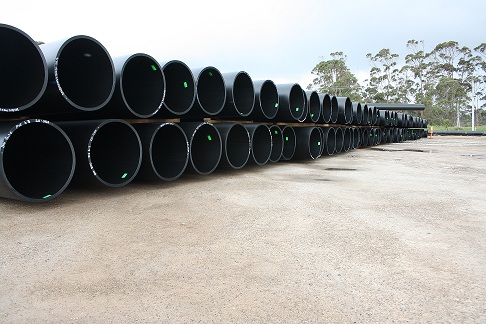HDPE PIPE
One of the first decisions to be made in the design of a system for potable water or natural gas reticulation is the choice of material. High-density polyethylene HDPE pipe provides a safe and low whole-of-life cost solution in a wide range of applications.
High-density polyethylene is a ductile, durable, inert thermoplastic made from polymerised ethylene. HDPE materials were first seen in Germany in early 1950's and have progressively been used in the pipeline industry since then. The physical properties of the HDPE pipe materials have been continually improved with increases in resistance to slow and rapid crack propagation, increased hydrostatic pressure resistance and performance at elevated temperature, all stemming from developments in the polymerisation process. These developments have resulted in a far broader range of applications for HDPE pipe, including gas reticulation, water supply, mining slurries, irrigation, sewer and general industrial applications.
HDPE Pipe can bend and curve at angles that would exceed manufacturer specifications and cause more rigid types of pipe material to break. This is helpful both in new construction and in exposed crossings.
In theory, there are virtually no joints in an HDPE piping network. The change-of-direction sections are fused to the pipe using either butt fusion or electrofusion. The system is monolithic once the fusion process is complete.
HDPE is more durable and forgiving in most applications. For example, a scratch as deep as 10% of the wall thickness doesn’t reduce the pressure rating of HDPE pipe. Moreover, HDPE piping systems are more surge tolerant, which means fewer repairs caused by pressure surges. If an HDPE piping system is in need of repair, electrofusion couplings are the simplest way to facilitate repairs. The days of thrust blocks and joint restraints are gone, because everything is fused together.
HDPE pipe can tolerate freezing much better than rigid pipe, an important consideration in alpine areas. HDPE stays ductlile deep in sub-zero temperatures which means less potential for failure. In fact, water can freeze and thaw repeatedly inside of HDPE pipe without causing permanent damage to the pipe. With proper fusion, HDPE does not have joints that fail.

From an environmental stand point, HDPE pipe is inert and will not readily react with other chemicals. Furthermore, the production of HDPE is far less destructive to the environment than the manufacture of other types of pipe material. HDPE pipe has been used in water-works for more than 50 years, so it has a proven track record of reliability.
Qenos offers a full range of Alkadyne PE100 Pipe Extrusion Grades used in a wide variety of demanding applications including water conservation and delivery, irrigation, waste management, mining and gas. The Qenos range includes PE100 and PE80B classified grades for use in pressure pipes and fittings.

